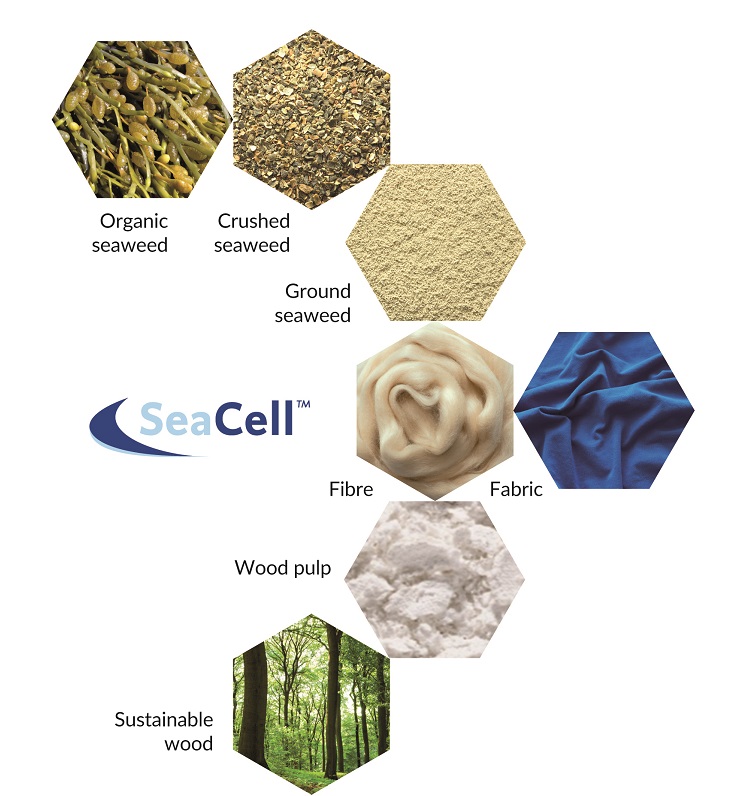Seaweed or sea vegetables are forms of algae that grow in the sea. They are mostly found in a range of colors from red to green to brown to black. They are mostly found around the rocky shorelines and are consumed in Asian countries such as Japan, Korea and China.
But have you ever imagined that one day you will be able to wear clothes made from these seaweeds. Astonishing, right!
Many beauty and healthcare products are already available in the market and now this seaweed has also made its entry into the world of eco-fashion. Yes, two companies SeaCell and AlgiKnit have already launched sustainable biodegradable textiles made from seaweed. Many big brands like lululemon and Frank and Oak used seaweed fiber for producing knits, underwear, and athleticwear.
Fiber made from seaweed is water-soluble. Hence, during the production process, they are usually combined with cellulosic fiber obtained from eucalyptus trees which serve as the ‘functioning substrate’ for the seaweed. In the finished cloth, the alginate gets dissolved. The blended fiber obtained from eucalyptus fiber and seaweed fiber has numerous benefits for human skin. When compared to conventional methods of antimicrobial finish, this innovative fiber provides an antibacterial effect through the incorporation and activation of the metal ions into the seaweed during the lyocell process.
AlgiKnit
AlgiKnit is a New York-based biotech start-up that produces durable yarns fully from seaweed-based fibers. They use algae called oarweed that grows 10 times faster than bamboo. The ‘bio yarn’ polymer produced by AlgiKnit using oarweed uses a closed-loop production i.e. it can be easily broken down by specific microorganisms and then can be used to feed the next round of kelp. It is ultra renewable and is used for making knitted fabrics and sportswear.

For the production of yarn, a substance called alginate is extracted from seaweed or algae. For further processing, this alginate is combined with other renewable biopolymers. Due to good strength and elasticity, the seaweed fiber can be knitted into textiles and is also suitable for 3D printing processes. Since the yarn gets its color from the natural pigments present in seaweed, hence the application of toxic dyeing chemicals is completely eliminated. Also, this sustainable fabric has a very low carbon footprint. This innovation has won many awards and recognition from National Geographic, the Fashion Institute of Technology, and the American Association of Textile Chemists and Colorists. They even have designed and showcased an in-house performance shoe.
Seacell
Nanonic Inc, a Florida-based corporation has developed luxurious silky fiber made from Seaweed and Eucalyptus fiber under the brand name Seacell. The main difference of Seacell from AlgiKnit is that it uses an additive blended with cellulose, which is wood-based. Seacell is made from brown algae called Ascophyllum nodossum, also known as Knotted Wrack. This alga is mainly found in the fjords of Iceland in locations where there is no waste and no pollution from ship traffic. Seacell fabric is manufactured in the same way as lyocell. Cellulose is directly dissolved in a solvent containing water. After the washing and retting process, the solution is filtered and spun through a solvent-spinning process to yield filaments.
The fiber is produced exclusively from sustainable raw materials i.e. wood and seaweed – using methods that save both energy and resources. The fiber is also carbon neutral and completely biodegradable. Seacell has been awarded by European Union with the 2000 European Environmental Award in the category “technology for sustainable development”. This fabric can be used for underwear, sportswear, bed sheet, decoration, and other fabric that contact skin.

Let’s talk about the environmental benefits of seaweed fiber.
Seaweed can grow up to 2 feet/day, can sequester 20 times the carbon of terrestrial forest, and also work in tandem with mangroves in protecting coastline communities from storms. Their presence in the coastline absorbs a lot of sewer and agricultural run-off and uses it to further growth. Along with this, seaweed also provides habitats for a huge variety of marine species like fish, coral reefs, etc. Clothes made from Seaweed are environment friendly as they can grow very fast and also eat carbon.
The biggest advantage of this Eco-friendly fabric is that it contains Ayurvedic benefits for the skin. They have anti-inflammatory properties and improve skin’s looks naturally. The substances found in seaweed help to activate the cell regeneration, which in turn can help to relieve skin diseases, reduce inflammation and soothe itchiness. Seaweed contains minerals and vitamins such as carbohydrate, amino acid, fat, cellulose, calcium, magnesium, sodium, and vitamin A, E, C constituents, etc. This type of fabric is very much suitable for children’s clothing, sleepwear, underwear, and activewear.
What do you think of Seaweed fiber? Share your thoughts in the comments below. We’d love to hear from you!
REFERENCES: